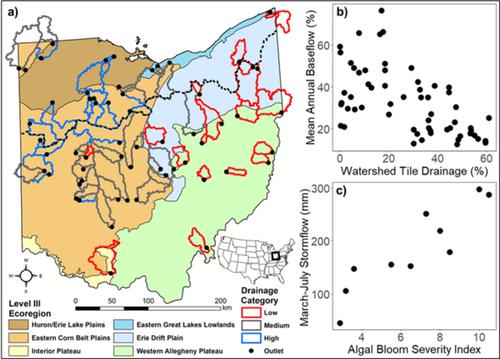当前位置:
X-MOL 学术
›
Hydrol. Process.
›
论文详情
Our official English website, www.x-mol.net, welcomes your feedback! (Note: you will need to create a separate account there.)
Tile drainage causes flashy streamflow response in Ohio watersheds
Hydrological Processes ( IF 3.2 ) Pub Date : 2021-07-26 , DOI: 10.1002/hyp.14326 Samuel A. Miller 1, 2 , Steve W. Lyon 1, 2
Hydrological Processes ( IF 3.2 ) Pub Date : 2021-07-26 , DOI: 10.1002/hyp.14326 Samuel A. Miller 1, 2 , Steve W. Lyon 1, 2
Affiliation

|
Artificial subsurface (tile) drainage is used to increase trafficability and crop yield in much of the Midwest due to soils with naturally poor drainage. Tile drainage has been researched extensively at the field scale, but knowledge gaps remain on how tile drainage influences the streamflow response at the watershed scale. The purpose of this study is to analyse the effect of tile drainage on the streamflow response for 59 Ohio watersheds with varying percentages of tile drainage and explore patterns between the Western Lake Erie Bloom Severity Index to streamflow response in heavily tile-drained watersheds. Daily streamflow was downloaded from 2010 to 2019 and used to calculated mean annual peak daily runoff, mean annual runoff ratio, the percent of observations in which daily runoff exceeded mean annual runoff (TQmean), baseflow versus stormflow percentages, and the streamflow recession constant. Heavily-drained watersheds (>40% of watershed area) consistently reported flashier streamflow behaviour compared to watersheds with low percentages of tile drainage (<15% of watershed area) as indicated by significantly lower baseflow percentages, TQmean, and streamflow recession constants. The mean baseflow percent for watersheds with high percentages of tile drainage was 20.9% compared to 40.3% for watersheds with low percentages of tile drainage. These results are in contrast to similar research regionally indicating greater baseflow proportions and less flashy hydrographs (higher TQmean) for heavily-drained watersheds. Stormflow runoff metrics in heavily-drained watersheds were significantly positively correlated to western Lake Erie algal bloom severity. Given the recent trend in more frequent large rain events and warmer temperatures in the Midwest, increased harmful algal bloom severity will continue to be an ecological and economic problem for the region if management efforts are not addressed at the source. Management practices that reduce the streamflow response time to storm events, such as buffer strips, wetland restoration, or drainage water management, are likely to improve the aquatic health conditions of downstream communities by limiting the transport of nutrients following storm events.
中文翻译:

瓷砖排水导致俄亥俄州流域的华丽水流响应
由于土壤自然排水不良,人工地下(瓷砖)排水系统用于提高中西部大部分地区的通行性和作物产量。瓦片排水已在现场范围内进行了广泛研究,但关于瓦片排水如何影响流域尺度的水流响应仍存在知识空白。本研究的目的是分析瓦片排水对具有不同瓦片排水百分比的 59 个俄亥俄州流域的水流响应的影响,并探索西伊利湖布鲁姆严重指数与瓦片排水严重的流域中的水流响应之间的模式。下载 2010 年至 2019 年的日径流量,用于计算年平均日径流量峰值、年平均径流量比、日径流量超过年平均径流量的观测值百分比(TQmean )、基流与风暴流的百分比,以及径流衰退常数。与低瓦片排水百分比(< 流域面积的 15%)的流域相比,重度排水流域(>40% 的流域面积)始终报告更闪亮的水流行为,如显着较低的基流百分比、T Qmean和水流衰退常数所示。瓷砖排水率高的流域的平均基流百分比为 20.9%,而瓷砖排水率低的流域为 40.3%。这些结果与区域性的类似研究形成对比,表明更大的基流比例和更少的浮华过程线(更高的T Qmean) 用于严重排水的流域。严重排水流域的暴雨径流指标与伊利湖西部藻华严重程度呈显着正相关。鉴于最近中西部地区出现更频繁的大雨事件和温度升高的趋势,如果不从源头上解决管理工作,有害藻华的严重程度将继续成为该地区的生态和经济问题。减少河流对风暴事件响应时间的管理实践,例如缓冲带、湿地恢复或排水管理,可能通过限制风暴事件后营养物质的运输来改善下游社区的水生健康状况。
更新日期:2021-08-23
中文翻译:

瓷砖排水导致俄亥俄州流域的华丽水流响应
由于土壤自然排水不良,人工地下(瓷砖)排水系统用于提高中西部大部分地区的通行性和作物产量。瓦片排水已在现场范围内进行了广泛研究,但关于瓦片排水如何影响流域尺度的水流响应仍存在知识空白。本研究的目的是分析瓦片排水对具有不同瓦片排水百分比的 59 个俄亥俄州流域的水流响应的影响,并探索西伊利湖布鲁姆严重指数与瓦片排水严重的流域中的水流响应之间的模式。下载 2010 年至 2019 年的日径流量,用于计算年平均日径流量峰值、年平均径流量比、日径流量超过年平均径流量的观测值百分比(TQmean )、基流与风暴流的百分比,以及径流衰退常数。与低瓦片排水百分比(< 流域面积的 15%)的流域相比,重度排水流域(>40% 的流域面积)始终报告更闪亮的水流行为,如显着较低的基流百分比、T Qmean和水流衰退常数所示。瓷砖排水率高的流域的平均基流百分比为 20.9%,而瓷砖排水率低的流域为 40.3%。这些结果与区域性的类似研究形成对比,表明更大的基流比例和更少的浮华过程线(更高的T Qmean) 用于严重排水的流域。严重排水流域的暴雨径流指标与伊利湖西部藻华严重程度呈显着正相关。鉴于最近中西部地区出现更频繁的大雨事件和温度升高的趋势,如果不从源头上解决管理工作,有害藻华的严重程度将继续成为该地区的生态和经济问题。减少河流对风暴事件响应时间的管理实践,例如缓冲带、湿地恢复或排水管理,可能通过限制风暴事件后营养物质的运输来改善下游社区的水生健康状况。



























 京公网安备 11010802027423号
京公网安备 11010802027423号